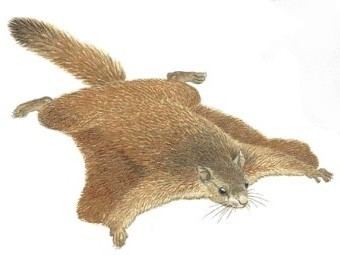Tribe Pteromyini Phylum Chordata Rank Species | Family Sciuridae Scientific name Trogopterus xanthipes Higher classification Trogopterus Order Rodent | |
 | ||
Genus TrogopterusHeude, 1898 Similar Groove‑toothed flying squirrel, Large black flying squirrel, Hylopetes, Petaurista, Red and white giant flying squ | ||
The complex-toothed flying squirrel (Trogopterus xanthipes) occurs in the southern Chinese provinces Hubei, Hunan, Guizhou, Sichuan, and Yunnan. The common name refers to the teeth, which differ from those of other species of flying squirrels.
Contents
Description
Trogopterus xanthipes looks much like other flying squirrels, but with a characteristic tuft of black hair below the base of the ear. The fur is generally grey-brown, but white beneath. There is a slight reddish tinge to the face and the tail. The overall length is about 60 cm, of which the tail is about half.
Conservation
The conservation status of the complex-toothed flying squirrel is near threatened because the population is shrinking as a result of habitat loss and excessive hunting for food and traditional Chinese medicine.
Biology and Reproduction
T. xanthipes builds its nests in cliffs, usually around 30 m above the ground. They live in mountainous terrain in altitudes of 1300 to 1500 m above sea level, or even up to 2750 m according to some sources. Their activity pattern is nocturnal; they leave their nests at night to search for food such as nuts, fruits, and leaves. They become sexually mature at about 22 months. A litter may comprise up to four young, and gestation lasts for roughly 80 to 90 days. Captive specimens have been reported to live for ten to twelve years.
Taxonomy
Though five species of the genus Trogopterus have been described, current opinion favours including them all in the same species: Trogopterus xanthipes. The hairy-footed flying squirrel (Belomys pearsoni) is closely related, and may be added to the genus Trogopterus.
Medical and commercial interest
The species is collected as a meat animal, and also is captured for collection of the fecal matter, which is valued in traditional Chinese medicine as "five spirits grease" (五靈脂, wǔ líng zhī). It is used in the treatment of ulcers in the duodenum. Recent research has attempted to establish whether the fecal matter includes components of possible medical interest. Antithrombotic flavonoids have been reported. Various diterpenoids, both known and unknown, have been evaluated for cytotoxicity against human tumor cell lines, and so have various neolignans classed as trogopterins. Although none of the compounds showed clinically significant activity against important tumor cell lines, some did produce detectable cytotoxic effects, suggesting a source of lignans with cytotoxic activity.
